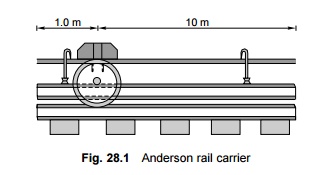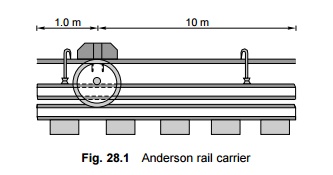Chapter: Civil : Railway Airport Harbour Engineering : Railway Engineering : Construction of New Railway Lines and Track Linking
Railway Plate Laying or Track Linking

Plate Laying or Track Linking
Once the formation is ready, plate laying or track linking should be done, which basically consists of laying rails, sleepers, and fastenings. The following methods can be adopted for plate laying.
Tram line method
In this method, a temporary line known as a tram line is laid by the side of the proposed track for transporting track material to the site. This method can be useful in flat terrains, where laying of a tram line on the natural ground may be comparatively easier. This method is, however, seldom used in actual practice.
A modification of the above method, called side method, is also in practice, where track and bridge material such as steel girders and RCC slabs is carried to the site in trucks on a service road that runs parallel to the track. These materials are then unloaded near the work site. This method is used only in cases where the terrain is comparatively flat.
American method
In this method, rails and sleepers are first assembled in the base depot, and the pre-assembled track panels are then conveyed to the site along with the necessary cranes, etc. The track panels are then unloaded at the site of work either manually or with the help of cranes and laid in their final position.
This procedure is used in many developed countries, particularly where concrete sleepers are laid, which are quite heavy and not very easy to handle manually.
Telescopic method
This method is widely used on Indian Railways. In this method, the rails, sleepers, and other fittings are taken to the base depot and unloaded. The track material is then taken to the rail head, where the tracks linked and packed. The rail head is then advanced up to the point where the track has been laid. The track materials are then taken up to the extended rail head with the help of a dip lorry and the track is linked and packed again. Thus the rail head goes on advancing till the entire track has been linked. The main operations involved in this method are as follows.
Unloading of materials The track materials are taken to the base depot and unloaded with the help of material gangs. The first base depot lies at the junction of the existing line and the new line to be constructed. All the track material is taken from the base depot to the rail head with the help of a dip lorry (a special type of trolley). The rail head goes on advancing till the track is sufficiently linked. After that, a subsidiary depot is established at a distance of about 5 km and track material carried to this depot with the help of a material train. Alternatively, track material is transferred from the base depot with the help of a dip lorry up to a distance of about 2 km and by the means of a material train beyond this distance. The base depot has arrangements for advanced processes such as adzing and boring of sleepers as well as for matching materials, etc. to ensure the speedy linking of the track at the site.
Linking of track Once the track material is unloaded, the track is linked with the help of linking gangs. The following procedure is normally adopted for this purpose.
1.A string is first stretched along the central line of the alignment and the sleepers are laid with their centres on the string. The sleepers are laid roughly at the desired spacing, keeping the total number of sleepers per rail intact.

2.The rails are carried using rail tongs and laid on the cess of the bank almost near the final position. Carrying rails is a strenuous job, as about 12 to 15 gangmen are required to carry each rail (each rail weighs about 0.6 t or so). A special type of rail carrier known as the Anderson rail carrier, shown in Fig. 28.1, can be used for carrying rails with lesser strain.
3. Next the sleepers are distributed over the length of the formation. The rails have markings to indicate the final position of the sleepers as shown in Fig. 28.1.
4. Small fittings such as fish plates and bolts are kept near the joints. The fittings required for each sleeper are kept near the ends of the sleepers.
5. The rails are then placed on the sleepers and fixed with the help of fittings, which are chosen depending upon the type of sleeper. For example, rail screws are used for fixing rails to wooden sleepers. In the case of steel sleepers, rails are fixed with the help of keys. Bearing plates are also provided wherever required, as per the prescribed track standards.
6. The rails are joined with each other after ensuring that there is sufficient gap between them. Normally, the initial laying of the tracks is done using three rail panels. Adequate expansion gaps should be provided in the case of single-rail as well as three-rail panels. The recommended expansion gaps are provided with the help of steel liners or shims of appropriate thickness (1 mm to 4 mm), which are fixed between the two rail ends.
Packing of track The track is then thoroughly packed with the help of beaters by the Packing-in-gangs. The following aspects should be examined during this process.
(a) The track should have a proper gradient.
(b) If the track is on a curve, it should have proper curvature.
(c) The cross levels should be even. If a track is to be provided with the recommended superelevation, this can be achieved by raising the outer rail.
(d) The track should be thoroughly packed and should be free of hollow spaces.
Ballasting of track The railway line is normally covered with the ballast after the embankment has settled and has endured at least two monsoons. Ballasting is generally done with the help of a ballast train, which has special hoppers that are used for automatically unloading the ballast onto the track. Alternatively, the ballast is taken to the cess and then placed on the track manually. Either method ensures that the ballast is thoroughly packed and inserted properly under the track.
Related Topics